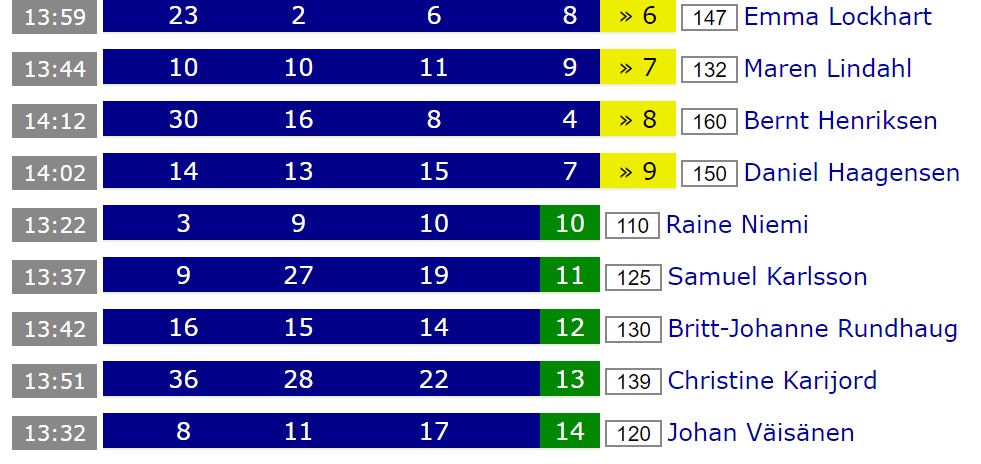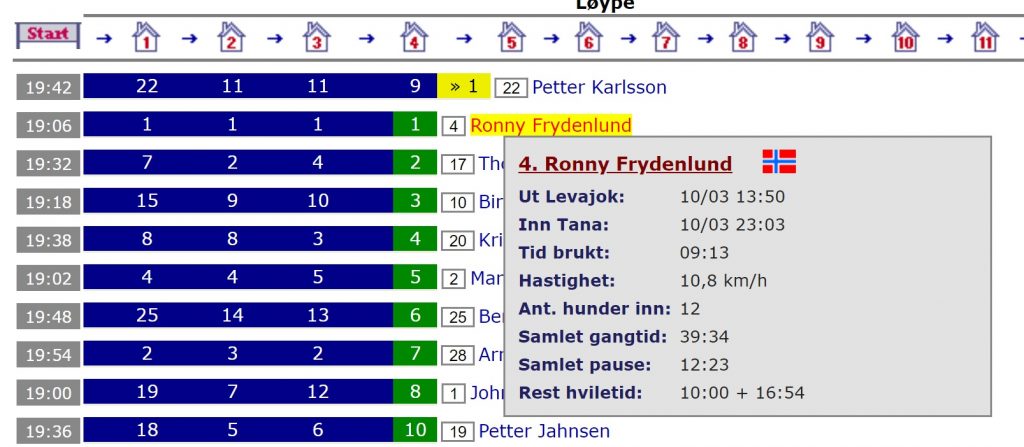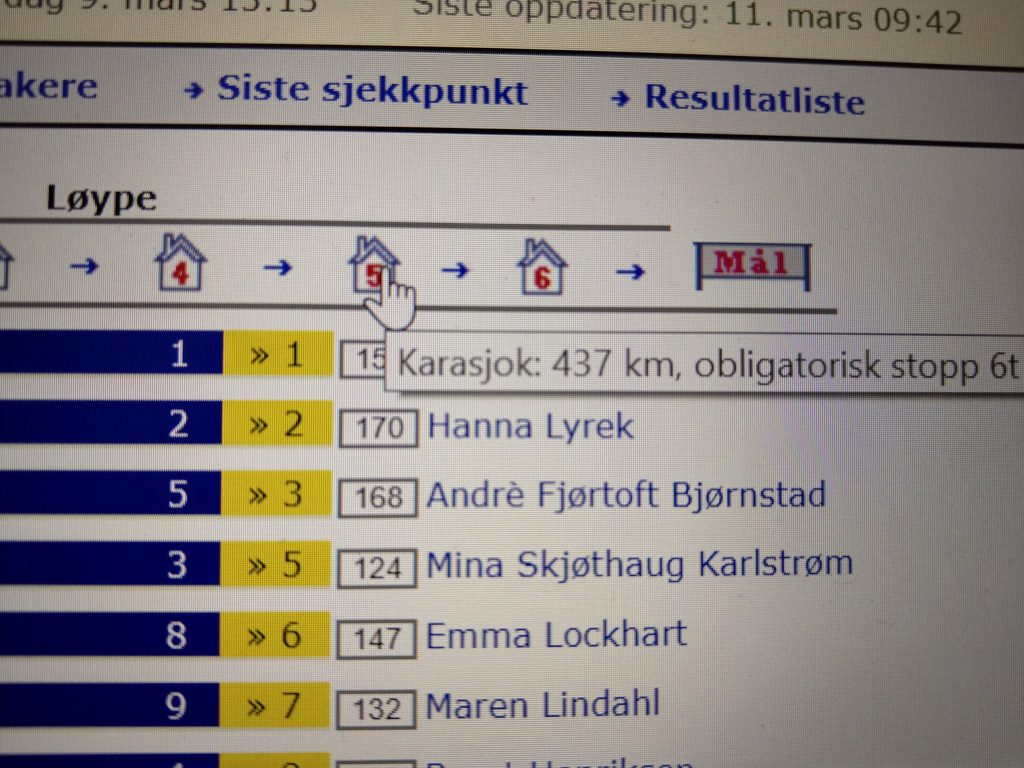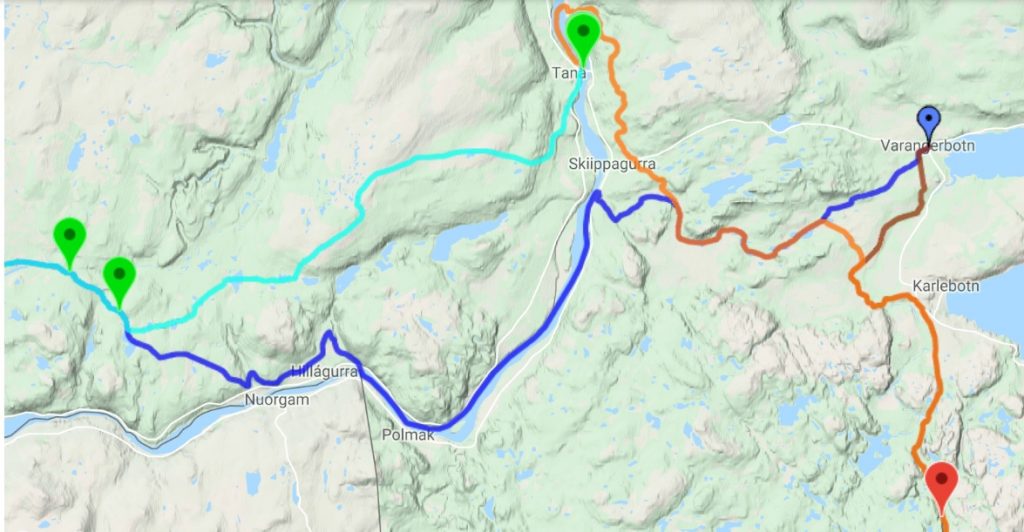Current standings for dummies
What can you really read from the list of current standings? How does this fit with the GPS tracking map? How can someone be in the lead on the trail without being in the lead of the race? In this article, we help you understand the basics.
You have a wide array of options to keep updated on the Finnmark Race while it goes on. Current standings, (free) GPS-tracking on the map, live (free/open) online TV streaming … The options are endless. And we haven’t even started talking about what Facebook offers yet in this respect.
In this article, we focus on the current standings and the GPS tracking map because the two are closely related.

One musher, one horizontal line.
On the current standings table, each musher has his/her own horizontal ‘line’ with their name on it. If the right-hand end of that line is green, it means that the musher is at a given checkpoint. If the end of that line is yellow, it means that the musher and the dog team are on trail between two checkpoints. If the end of that line is red, it will also have a big black X on it. That means that the musher/team has scratched from the race and is no longer part of the competition.
The left end of the horizontal line is colored blue for the checkpoints and legs the musher and the team have passed. You will find a number printed in white on each checkpoint. That refers to the place the musher had at the time of arriving at that particular checkpoint.

Key facts about the musher may come in handy
You can also let the mouse pointer hover over the musher’s name without clicking. A small box will appear that provides you with key facts about the musher and the team at that given time. You can see when he/she last arrived at or left the previous or current checkpoint, number of dogs still on the team, remaining mandatory rest time, and a other key facts are available here.
If you are curious about how many dogs they must or can have or other details, you will often find the answers in the special regulations for the Finnmark Race.

One house, one checkpoint
How long is this leg? What is the next checkpoint? At the very top of the table of current standings, above all the musher names, you will see a small blue houses lined up and numbered. Each house represents a checkpoint. If you let your pointer hover (without clicking) above a house, a box will appear that tells you the checkpoint’s name, how far it is from the starting line and potentially other vital information about that checkpoint – such as e.g. mandatory resting time.
If you click on the house, you will see a status page for this particular checkpoint. It will tell you how long time it has taken the different teams to get there, who arrived first or last, who is expected and a series of other details.
Current standings and GPS tracking map
The GPS tracking map basically tells you where each musher and team are at any given point of time. If the musher’s marker is green, it means that the signal is rather fresh and the indication reliable. If the marker is orange, it has missed an update or two (they update at regular, fixed intervals). If the marker is red, it means that it has been a while since the last update went through and that the indication is rather out-of-date. Most likely, the musher and his/her team are further ahead on the trail.

One musher, one marker, one colour
Markers will sometimes be red if the mushers for instance are in areas with poor connections, if the GPS battery is low, or for a number of other technical reasons. Mushers are prohibited from hiding their GPS trackers in order to hide where they are at on the trail.
Exhaustive image
The table of current standings along with the GPS tracking map combined provide you with rather updated information about the status of the race at any given time. If a musher has spent 11 hours on a leg where others only used 8, it indicates that the former one has chosen to rest on the trail with the dogs. The GPS marker will then also have shown that the team was at a given location for a longer period of time before moving on.
When two mushers compete more or less neck-and-neck, you can often see it if you zoom in close on the GPS map. You may see one of them stopping a little (for instance to snack his dogs or change the booties for dogs on her team) while the other one passes them by, and for this later to happen in reversed order. If it appears that a group of mushers are traveling more or less together, you will often see – if you zoom in – that they take turns leading the pack. This does in particular apply when it is snowing and they have to take turns breaking the trails. While they are competitors, the mushers fortunately also demonstrate good sportsmanship. (There is even a Good Sportsmanship Award to be handed out at the post-race banquet!)
So – now you can over over the current standings table, the GPS tracking map, live broadcasts (no subsciption required) and not to forget the Finnmark Race Facebook page, which is a key source of information and updates on current standings. Happy trails, and happy armchair mushing!



